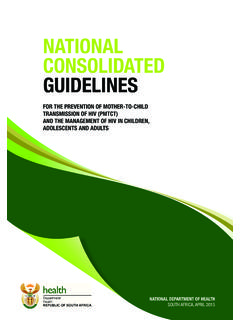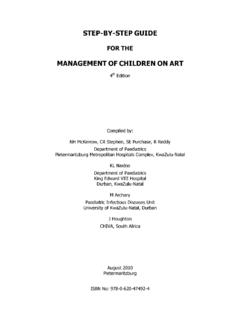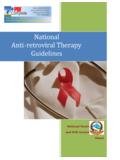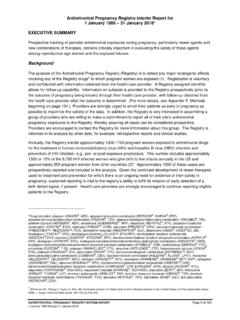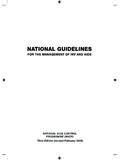Transcription of GUIDELINES GUIDELINE ON WHEN TO START …
1 GUIDELINE ON when TO START ANTIRETROVIRAL THERAPY AND ON PRE-EXPOSURE PROPHYLAXIS FOR HIV SEPTEMBER 2015 GUIDELINESThis early-release GUIDELINE will form part of the revised updated WHO consolidated GUIDELINES on the use of antiretroviral drugs for treating and preventing HIV infection due to be published in ON when TO START ANTIRETROVIRAL THERAPY AND ON PRE-EXPOSURE PROPHYLAXIS FOR HIV SEPTEMBER 2015 WHO Library Cataloguing-in-Publication DataGuideline on when to START antiretroviral therapy and on pre-exposure prophylaxis for Infections drug therapy. Agents administration and dosage. agents therapeutic use. Health 978 92 4 150956 5 (NLM classification: WC ) World Health Organization 2015 All rights reserved. Publications of the World Health Organization are available on the WHO website ( ) or can be purchased from WHO Press, World Health Organization, 20 Avenue Appia, 1211 Geneva 27, Switzerland (tel.)
2 : +41 22 791 3264; fax: +41 22 791 4857; e-mail: Requests for permission to reproduce or translate WHO publications whether for sale or for non-commercial distribution should be addressed to WHO Press through the WHO website ( ).The designations employed and the presentation of the material in this publication do not imply the expression of any opinion whatsoever on the part of the World Health Organization concerning the legal status of any country, territory, city or area or of its authorities, or concerning the delimitation of its frontiers or boundaries. Dotted and dashed lines on maps represent approximate border lines for which there may not yet be full mention of specific companies or of certain manufacturers products does not imply that they are endorsed or recommended by the World Health Organization in preference to others of a similar nature that are not mentioned. Errors and omissions excepted, the names of proprietary products are distinguished by initial capital reasonable precautions have been taken by the World Health Organization to verify the information contained in this publication.
3 However, the published material is being distributed without warranty of any kind, either expressed or implied. The responsibility for the interpretation and use of the material lies with the reader. In no event shall the World Health Organization be liable for damages arising from its use. Printed in SwitzerlandGuideline on when to START antiretroviral therapy and on pre-exposure prophylaxis for HIV5 Abbreviations and acronyms 6 Definition of key terms 7 Acknowledgements 9 Executive summary 12 Summary of new recommendations 13 1. Introduction 16 Health sector response to HIV 16 Objectives 16 Target audience 17 Guiding principles 17 Methods for developing the GUIDELINES Competing interests GUIDELINE contributors Methods for evidence synthesis Peer review 212. Recommendations 24 when to START antiretroviral therapy when to START ART among adults (>19 years old) when to START ART among pregnant and breastfeeding women when to START ART among adolescents (10 19 years of age) when to START ART among children (younger than 10 years of age) 38 Oral pre-exposure prophylaxis for preventing the acquisition of hiv infection 42 Programmatic note on the recommendations 503.
4 Publication, dissemination and evaluation 54 References 55 Annex 1. Declaration of interests, Clinical GUIDELINE Development Group, June 2015 68 Annex 2. Evidence to decision-making tables and supporting evidence (available in web annex)CONTENTSC ontentsContents6 GUIDELINE on when to START antiretroviral therapy and on pre exposure prophylaxis for HIVABBREVIATIONS AND ACRONYMSAIDS acquired immunodeficiency syndromeART antiretroviral therapyARV antiretroviralFTC emtricitabineGRADE grading of recommendations, assessment, development and evaluationHIV human immunodeficiency virusPICO population, intervention, comparison and outcomePMTCT prevention of mother-to-child HIV transmissionPrEP pre-exposure prophylaxisTB tuberculosisTDF tenofovir disoproxil fumarateUNAIDS Joint United Nations Programme on HIV/AIDSWHO World Health Organization7 GeneralHIV refers to the human immunodeficiency virus .
5 There are two types of hiv : HIV-1 and is responsible for the vast majority of hiv infections groups and populationsThe following definitions for adults, adolescents, children and infants are used to ensure consistency within these GUIDELINES . Other agencies may use different definitions. An adult is a person older than 19 years. An adolescent is a person 10 19 years old inclusive. A child is a person younger than 10 years old. An infant is a child younger than one year of couples are couples in which one partner is living with HIV and the other is HIV-negative. A couple refers to two people in an ongoing sexual relationship; each of these people is referred to as a partner in the relationship. How individuals define their relationships will vary according to their cultural and social populations are groups that have a disproportionate burden of hiv in many settings. They frequently face legal and social challenges that increase their vulnerability to HIV, including barriers to accessing HIV prevention and treatment.
6 Key populations include (1) men who have sex with men, (2) people who inject drugs, (3) people in prisons and closed settings, (4) sex workers and (5) transgender populations are populations that are vulnerable to HIV in certain situations or contexts, such as adolescents (particularly adolescent girls in sub-Saharan Africa), orphans, people with disabilities and migrant and mobile workers. They may also face social and legal barriers to accessing HIV prevention and treatment. These populations are not affected by HIV uniformly in all countries and epidemics. Each country should define the specific populations that are vulnerable and key to their epidemic and response, based on the epidemiological and social therapyARV (antiretroviral) drugs refer to the medicines used to treat (antiretroviral therapy) refers to the use of a combination of three or more ARV drugs for treating HIV infection. ART involves lifelong of ARV drugs for HIV prevention refers to the HIV prevention benefits of ARV drugs and includes ARV drugs given to the mother or infant for preventing the mother-to-child transmission of hiv (PMTCT), ARV drugs to reduce the transmission of hiv among serodiscordant couples and ARV drugs to prevent people from acquiring HIV when they are exposed (post-exposure prophylaxis (PEP) and pre-exposure prophylaxis (PrEP).)
7 Viral suppression refers to a viral load below the detection threshold using viral failure refers to the inability to achieve or maintain viral suppression below a certain DEFINITION OF KEY TERMSD efinition of key termsDefinition of key terms8 GUIDELINE on when to START antiretroviral therapy and on pre exposure prophylaxis for failure: the current WHO virological criterion for treatment failure is 1000 copies per ml or access to ART is defined broadly as a high level of access (80% or more of the eligible population) that is accessible and affordable. It does not necessarily mean 100% access to ART is defined broadly as a high level of access (80% or more of the eligible population) that is accessible and affordable. It does not necessarily mean 100% the mother-to-child transmission of hiv : Previous WHO GUIDELINES have used the terms options A, B and B+ to refer to different approaches to preventing the mother-to-child transmission of hiv .
8 The 2013 WHO GUIDELINES recommended a choice between two approaches: (1) providing ART during pregnancy and breastfeeding to women who are otherwise not eligible for ART (option B) and (2) providing lifelong ART to all pregnant and breastfeeding women living with HIV regardless of CD4 count or clinical stage (option B+).Service deliveryContinuum of hiv services refers to a comprehensive package of hiv prevention, diagnostic, treatment, care and support services provided for people at risk of or living with HIV and their families. Examples of these services include combination HIV prevention including pre-exposure prophylaxis; HIV testing and linkage to care; management of opportunistic infections and other comorbid conditions; initiating, maintaining and monitoring ART; switching to second-line and third-line ART; and palliative of hiv care refers to a comprehensive package of hiv services for people living with public health approach addresses the health needs of a population or the collective health status of the people rather than focusing primarily on individual case management.
9 This approach aims to ensure the widest possible access to high quality services at the population level, based on simplified and standardized approaches, and to strike a balance between implementing the best-proven standard of care and what is feasible on a large scale in resource-limited settings. For HIV, key elements of a public health approach include simplified drug formularies; large-scale use of fixed-dose combinations for first-line treatment for adults, adolescents and children; care and drugs provided free at the point of service delivery; decentralization and integration of services, including task shifting; and simplified approaches to clinical preventionPrEP: Oral PrEP of hiv infection is the use of ARV drugs by HIV-uninfected people before the potential exposure to block the acquisition of risk of hiv infection is defined by an incidence of hiv infection in the absence of PrEP that is sufficiently high (>3% incidence) to make offering PrEP potentially cost-saving (or cost-effective).
10 Offering PrEP to people at substantial risk of hiv infection maximizes the benefits relative to the risks and costs. People at substantial risk of hiv infection are present in most countries, including some (but not all) people identified with key and vulnerable populations and some people not so HIV prevention refers to a combination of behavioural, biomedical and structural approaches to HIV prevention to achieve maximum impact on reducing HIV transmission and contributors to the evidence profilesSystematic reviews: Global Health Sciences, University of California, San Francisco and John Hopkins Bloomberg School of Public Health, : HIV Modelling Consortium, IeDEA Southern Africa Collaboration, IeDEA West Africa and COHERE literature reviews: Mami Kiritani, Florence Koechlin and Cadi Irvine (WHO consultants).Community consultations: African Community Advisory Board, AIDS Healthcare Foundation Ukraine, Asia Pacific Network of People Living with HIV, Asociacion Via Libre, European AIDS Treatment Group, Grupo Portugu s de Activistas sobre Tratamentos de VIH/SIDA and the International Community of Women Living with HIV/AIDS supported by Pangaea Global analysis: Paediatric AIDS Treatment for Africa (PATA).

